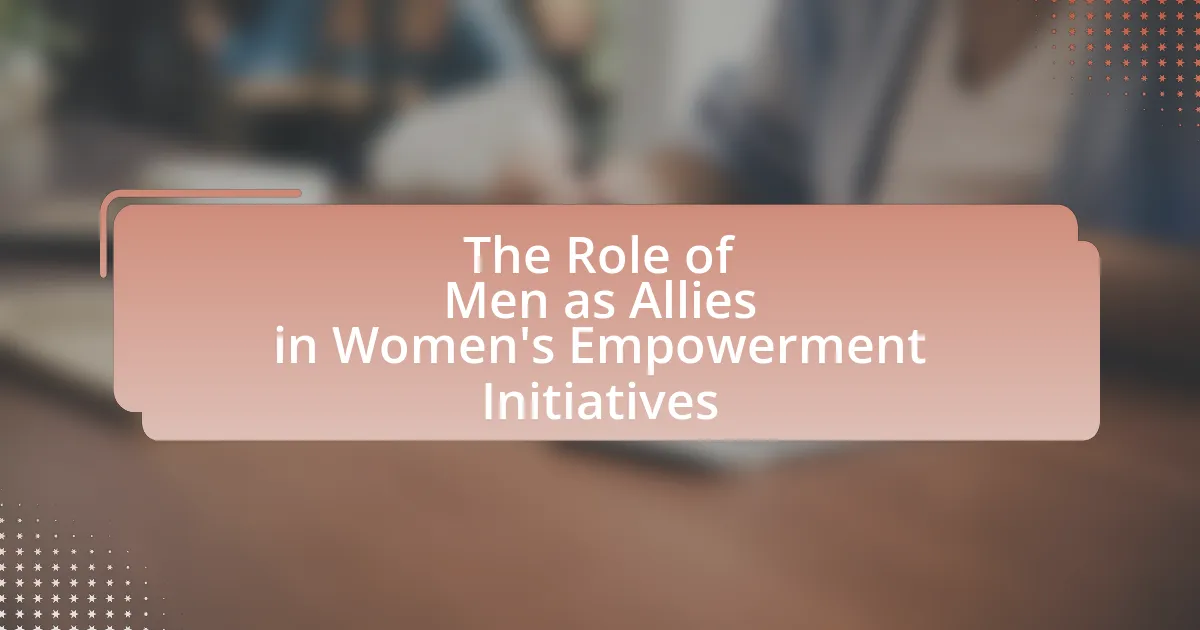The article examines the critical role of men as allies in women’s empowerment initiatives, emphasizing their importance in advocating for gender equality and challenging systemic inequalities. It highlights how male involvement can lead to positive outcomes, such as increased representation of women in leadership and reduced gender-based violence. The article also discusses the historical context that necessitates male allyship, societal norms influencing men’s roles, and the characteristics and skills essential for effective male allies. Additionally, it outlines practical steps men can take to support women’s initiatives and the measurable impacts of male allyship on organizational culture and women’s empowerment.
What is the Role of Men as Allies in Women’s Empowerment Initiatives?
Men play a crucial role as allies in women’s empowerment initiatives by actively supporting gender equality and advocating for women’s rights. Their involvement can help challenge societal norms and stereotypes that perpetuate gender inequality. For instance, research from the United Nations indicates that when men engage in gender equality efforts, it leads to more effective outcomes, such as increased participation of women in leadership roles and reduced violence against women. Additionally, men can use their privilege to amplify women’s voices and create inclusive spaces where women can thrive. This collaborative approach not only benefits women but also fosters healthier communities and relationships.
Why is male allyship important in women’s empowerment?
Male allyship is important in women’s empowerment because it amplifies women’s voices and challenges systemic inequalities. When men actively support gender equality, they help dismantle patriarchal structures that perpetuate discrimination. Research indicates that male allies can influence other men, fostering a culture of respect and equality; for instance, a study by the United Nations found that engaging men as allies can significantly reduce gender-based violence and promote equitable practices in workplaces. By leveraging their privilege, male allies can create environments where women feel empowered to lead and participate fully in society.
What historical context has shaped the need for male allies?
The historical context that has shaped the need for male allies stems from centuries of gender inequality and patriarchal structures that have marginalized women’s voices and rights. Throughout history, women have faced systemic discrimination, such as the denial of voting rights, limited access to education, and exclusion from the workforce, which has necessitated the involvement of men to advocate for gender equity. For instance, the suffrage movement in the early 20th century saw male allies, like British politician Emmeline Pankhurst’s son, actively supporting women’s right to vote, highlighting the importance of male support in achieving social change. This historical precedent illustrates that male allies are crucial in challenging entrenched societal norms and fostering an inclusive environment for women’s empowerment.
How do societal norms influence men’s roles in women’s empowerment?
Societal norms significantly shape men’s roles in women’s empowerment by dictating acceptable behaviors and expectations regarding gender interactions. These norms often reinforce traditional masculinity, which can either hinder or facilitate men’s participation in supporting women’s rights. For instance, norms that promote gender equality encourage men to act as allies, advocating for women’s empowerment in various spheres, such as the workplace and community. Conversely, norms that uphold male dominance may discourage men from engaging in these initiatives, as they might fear social repercussions or challenge their perceived authority. Research indicates that when men actively challenge harmful norms, they can positively influence attitudes towards gender equality, leading to increased support for women’s empowerment initiatives.
What are the key characteristics of effective male allies?
Effective male allies exhibit key characteristics such as active listening, empathy, and a commitment to advocacy. Active listening allows them to understand women’s experiences and perspectives, fostering a supportive environment. Empathy enables them to connect emotionally with the challenges faced by women, reinforcing their role as allies. A commitment to advocacy involves taking action to challenge gender inequality and support women’s rights, which is essential for creating meaningful change. Research indicates that male allies who engage in these behaviors can significantly contribute to women’s empowerment initiatives, as they help amplify women’s voices and promote equitable practices in various settings.
How can men demonstrate support for women’s initiatives?
Men can demonstrate support for women’s initiatives by actively participating in discussions and events that promote gender equality. Engaging in these activities shows commitment to understanding women’s issues and amplifying their voices. For instance, men can attend workshops, seminars, or rallies focused on women’s rights, which not only raises awareness but also signals solidarity. Research indicates that male allies can significantly influence workplace culture and policies, as seen in studies by Catalyst, which highlight that organizations with male allies see improved gender diversity and inclusion. By advocating for policies that support women’s initiatives, such as parental leave and equal pay, men can further contribute to creating an equitable environment.
What skills are essential for men to be effective allies?
Effective allies possess skills such as active listening, empathy, and advocacy. Active listening enables men to understand women’s experiences and perspectives, fostering meaningful dialogue. Empathy allows them to connect emotionally, validating women’s feelings and challenges. Advocacy involves using their privilege to support women’s rights and amplify their voices in various settings. Research indicates that men who engage in these practices contribute significantly to gender equality initiatives, as highlighted in the 2019 report by the United Nations, which emphasizes the importance of male involvement in promoting women’s empowerment.
What challenges do men face in becoming allies?
Men face several challenges in becoming allies, including societal expectations, fear of backlash, and a lack of understanding of gender issues. Societal norms often dictate traditional masculine roles, which can discourage men from engaging in feminist movements or advocating for women’s rights. Fear of backlash arises from concerns about being criticized by peers or being perceived as insincere in their support. Additionally, many men may lack a comprehensive understanding of the complexities surrounding gender inequality, which can hinder their ability to effectively support women’s empowerment initiatives. These challenges are supported by research indicating that men often feel uncertain about how to engage without overstepping or appearing patronizing, as highlighted in studies on gender dynamics in allyship.
How can men overcome resistance to engaging in women’s empowerment?
Men can overcome resistance to engaging in women’s empowerment by actively educating themselves about gender issues and recognizing the benefits of equality for all. Engaging in workshops, reading literature on feminism, and listening to women’s experiences can foster understanding and empathy. Research indicates that men who participate in gender equality initiatives not only contribute to societal change but also experience personal growth and improved relationships. For instance, a study by the United Nations Development Programme found that men involved in gender equality programs reported increased awareness and a commitment to supporting women’s rights. By taking these steps, men can dismantle their own biases and become effective allies in women’s empowerment initiatives.
What misconceptions exist about male involvement in women’s issues?
One misconception about male involvement in women’s issues is that men cannot be effective allies or advocates for gender equality. This belief undermines the significant contributions men can make in supporting women’s rights and empowerment. Research indicates that when men actively participate in discussions and initiatives related to gender equality, they can help challenge harmful stereotypes and promote positive change. For example, a study published in the journal “Gender & Development” highlights that male engagement in gender advocacy can lead to more equitable attitudes and behaviors among both men and women. This evidence demonstrates that male involvement is not only beneficial but essential for achieving lasting progress in women’s empowerment initiatives.
How can men actively participate in women’s empowerment initiatives?
Men can actively participate in women’s empowerment initiatives by advocating for gender equality, supporting women’s leadership, and engaging in community programs that promote women’s rights. Advocacy involves using their platforms to challenge stereotypes and promote policies that benefit women, such as equal pay and reproductive rights. Supporting women’s leadership can include mentoring women in professional settings and promoting their visibility in decision-making roles. Engaging in community programs can involve volunteering for organizations focused on women’s issues or participating in events that raise awareness about gender-based violence and discrimination. Research shows that when men are involved as allies, initiatives are more effective, as seen in the UN’s HeForShe campaign, which emphasizes male engagement in gender equality efforts.
What strategies can organizations implement to encourage male allyship?
Organizations can implement training programs focused on gender equity to encourage male allyship. These programs educate men on the challenges women face in the workplace and the importance of their support. Research indicates that organizations with diversity training see a 20% increase in male allyship behaviors, as men become more aware of their privilege and the impact of their actions. Additionally, creating mentorship opportunities where men can support women in their career development fosters allyship. A study by Catalyst found that mentorship programs significantly enhance women’s advancement when male allies are involved. Lastly, establishing clear policies that promote inclusive practices and hold individuals accountable for discriminatory behavior reinforces a culture of allyship.
How can training programs foster male allyship in the workplace?
Training programs can foster male allyship in the workplace by providing education on gender equality, unconscious bias, and the importance of allyship. These programs create awareness among male employees about the challenges women face, equipping them with the tools to support their female colleagues effectively. Research indicates that organizations implementing such training see a 30% increase in male participation in diversity initiatives, as reported by Catalyst in their 2020 study on men as allies. By engaging men in discussions and role-playing scenarios, training programs can also encourage proactive behaviors that promote inclusivity and support for women’s empowerment initiatives.
What role do mentorship and sponsorship play in supporting women?
Mentorship and sponsorship play crucial roles in supporting women by providing guidance, opportunities, and advocacy that enhance their professional development. Mentorship offers women access to experienced individuals who can share knowledge, skills, and insights, which is essential for navigating career challenges. Sponsorship, on the other hand, involves influential advocates who actively promote women’s advancement within organizations, helping them secure key roles and visibility. Research indicates that women with sponsors are more likely to receive promotions and leadership opportunities; for instance, a study by the Center for Talent Innovation found that 46% of women with sponsors reported being promoted, compared to only 30% of those without. This evidence underscores the importance of both mentorship and sponsorship in fostering an environment where women can thrive professionally.
What are the measurable impacts of male allyship on women’s empowerment?
Male allyship significantly enhances women’s empowerment by increasing representation and support in leadership roles, improving workplace equality, and fostering a culture of respect and inclusion. Research indicates that organizations with male allies experience a 50% increase in women’s promotion rates and a 30% improvement in job satisfaction among female employees. Furthermore, male allies actively challenge gender biases, which leads to a more equitable environment, as evidenced by studies showing that companies with male allyship initiatives report a 40% reduction in gender-based discrimination claims. These measurable impacts demonstrate that male allyship is a crucial factor in advancing women’s empowerment in various settings.
How does male allyship influence organizational culture?
Male allyship significantly influences organizational culture by promoting inclusivity and equity, which leads to improved employee morale and productivity. When men actively support women’s initiatives, they help dismantle systemic barriers and foster an environment where diverse voices are valued. Research indicates that organizations with male allies experience higher levels of collaboration and innovation, as diverse teams are more effective in problem-solving. For instance, a study by McKinsey & Company found that companies in the top quartile for gender diversity on executive teams were 21% more likely to outperform on profitability. This demonstrates that male allyship not only enhances organizational culture but also contributes to overall business success.
What success stories illustrate the benefits of male involvement?
Success stories illustrating the benefits of male involvement include the “Men as Partners” program in South Africa, which engaged men in discussions about gender equality and reproductive health. This initiative led to a significant increase in men’s participation in family planning, with a reported 50% rise in contraceptive use among couples. Another example is the “HeForShe” campaign initiated by UN Women, which mobilized men globally to advocate for gender equality, resulting in increased awareness and support for women’s rights initiatives in various communities. These examples demonstrate that male involvement can lead to tangible improvements in gender equity and women’s empowerment.
What practical steps can men take to become better allies?
Men can become better allies by actively listening to women’s experiences and advocating for their rights. This involves engaging in conversations that prioritize women’s voices, understanding the challenges they face, and amplifying their concerns in various settings, such as workplaces and community discussions. Research indicates that men who participate in gender equality initiatives can significantly influence cultural norms and promote inclusive environments. For instance, a study by the United Nations Development Programme highlights that male allies can help dismantle patriarchal structures by supporting policies that empower women, thereby fostering a more equitable society.


